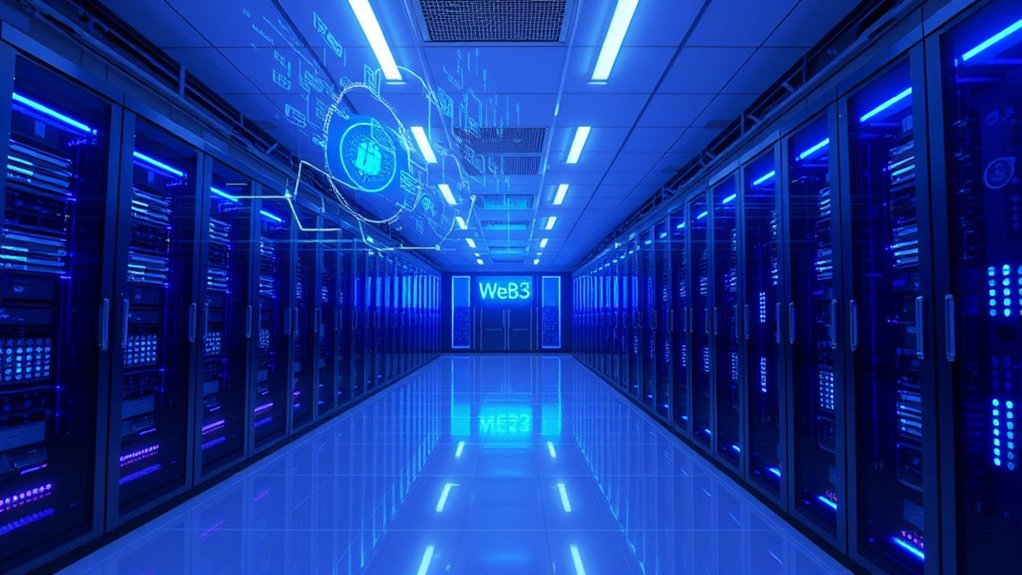Web3 infrastructure builds the decentralized web by using standardized tokens like ERC-20 and ERC-721, which guarantee assets work consistently across platforms. Interoperability protocols act as bridges, enabling different blockchains to communicate and share data smoothly. This interconnected system promotes seamless user experiences, reduces silos, and supports innovative multi-chain applications. As this infrastructure evolves, it empowers a more secure, efficient, and user-controlled digital ecosystem—continuing will reveal how these elements shape the future of web development.
Key Takeaways
- Token standards like ERC-20 and ERC-721 establish uniform rules for creating compatible, interoperable digital assets across platforms.
- Interoperability protocols serve as bridges, enabling seamless communication and data transfer between different blockchains.
- These standards and protocols foster a connected ecosystem, promoting user-friendly interactions and asset portability in Web3.
- They underpin the development of multi-chain applications, supporting scalable, decentralized, and resilient Web3 infrastructure.
- Overall, they drive the evolution of a decentralized web by enabling secure, efficient, and interconnected blockchain networks.

Have you ever wondered what powers the decentralized apps and digital assets of Web3? It all boils down to the backbone of the infrastructure that makes this new web possible. At the core are token standards and interoperability protocols, which guarantee that digital assets and decentralized applications can function smoothly across various platforms and blockchains. Token standards, like ERC-20 and ERC-721, set the rules for creating tokens that are compatible and easily exchangeable within the ecosystem. These standards define how tokens behave, what data they hold, and how they interact with wallets and smart contracts. Without these standards, each token would be a custom, isolated asset, making interoperability nearly impossible. They allow developers to build apps that recognize and handle tokens uniformly, fostering a seamless user experience. Additionally, token standards facilitate the development of new types of digital assets, such as non-fungible tokens, which expand the possibilities of blockchain utilization.
Interoperability protocols are equally essential. They act like bridges, enabling communication and data transfer across different blockchain networks. Think of them as universal translators that facilitate interoperability, which is necessary because no single blockchain can do everything. These protocols allow decentralized apps to tap into multiple chains, accessing different features, assets, and data sets without being limited to one network. This cross-chain communication broadens the scope of possibilities, making it easier to build complex, interconnected systems. Protocols like Polkadot, Cosmos, and LayerZero focus specifically on this, offering frameworks that enable different blockchains to work together efficiently. This interoperability is fundamental for Web3’s vision of a decentralized, user-controlled internet, where assets and data flow freely across platforms.
Together, token standards and interoperability protocols lay the foundation for a truly interconnected decentralized web. They help prevent silos, where assets or data are confined to a single platform, and instead promote a fluid ecosystem where assets can move freely between applications and networks. This makes Web3 more accessible, scalable, and user-friendly. As you navigate this space, you’ll see how these building blocks simplify complex transactions, support diverse assets, and enable innovative dApps that leverage multiple blockchains. They also foster a more competitive environment, encouraging developers to create interoperable solutions that improve overall network security and efficiency.
In essence, understanding token standards and interoperability protocols helps you grasp how Web3 is evolving into a resilient, interconnected web. These components are indispensable in building an infrastructure that promotes decentralization, enhances user control, and unlocks new possibilities for digital assets and applications. They’re the invisible forces powering a future where the internet isn’t controlled by a few centralized entities but is instead a decentralized, interoperable network that puts you, the user, in the driver’s seat.
Frequently Asked Questions
How Does Web3 Infrastructure Ensure User Privacy?
Web3 infrastructure guarantees your privacy by using encrypted transactions, making your data unreadable to outsiders. It also leverages decentralized identities, so you control your personal information without relying on centralized authorities. This setup prevents third parties from tracking or accessing your data, giving you more security and privacy online. By design, Web3 prioritizes user sovereignty, keeping your data safe and private while you interact with decentralized applications.
What Are the Main Challenges in Deploying Web3 Solutions?
You might think deploying Web3 solutions is straightforward, but interoperability issues and user onboarding pose significant hurdles. Many believe blockchain networks seamlessly connect, but fragmentation causes delays and confusion. You’ll face challenges ensuring users understand complex tech and securely onboard. Overcoming these obstacles requires better standards and user-friendly tools, making adoption smoother. These efforts are vital for Web3 to reach its full potential and truly decentralize the web.
How Does Scalability Impact Web3 Network Performance?
Scalability directly impacts your Web3 network’s performance by affecting how many transactions it can handle quickly. Scalability bottlenecks cause network congestion, slowing down transaction times and increasing fees. When the network gets overwhelmed, users face delays and higher costs, which can hinder adoption. To guarantee smooth performance, you need to address these bottlenecks with solutions like sharding or layer-2 protocols that improve scalability and reduce congestion.
What Role Do Tokens Play in Web3 Ecosystems?
Tokens play a essential role in Web3 ecosystems by serving as utility tools and governance mechanisms. You use tokens to access specific services, participate in decision-making, and influence the network’s development. They empower you to vote on proposals and shape the platform’s future. This dual role fosters decentralization, ensuring your participation and stake are crucial for the ecosystem’s growth and security.
How Can Developers Get Started With Web3 Infrastructure?
You can get started with Web3 infrastructure by learning smart contract development on platforms like Ethereum, which allows you to create decentralized applications. Focus on understanding decentralized identity solutions to enhance user privacy and security. Use developer tools like Remix or Hardhat to write, test, and deploy smart contracts. Engaging with community forums and tutorials will help you stay updated and build a strong foundation in creating decentralized web solutions.
Conclusion
As you build on Web3 infrastructure, you’re shaping a more open and resilient internet. Imagine a small business using decentralized platforms to securely manage transactions without relying on traditional banks, ensuring transparency and control. By embracing these technologies, you empower users and foster trust. The future of the decentralized web is in your hands—creating a more equitable and innovative digital world where everyone can participate freely.








